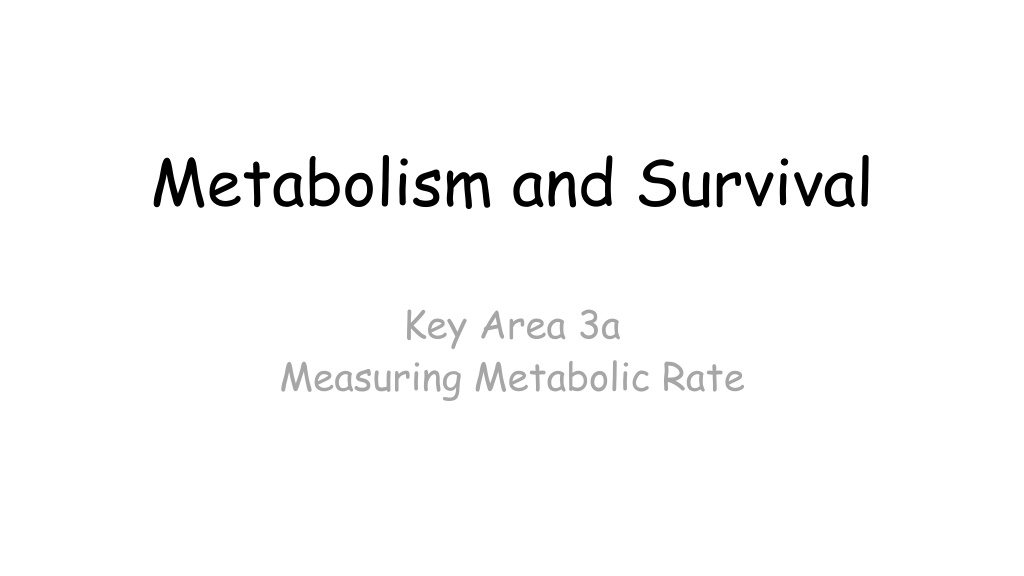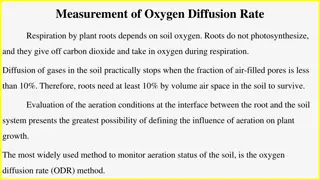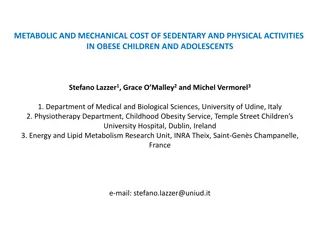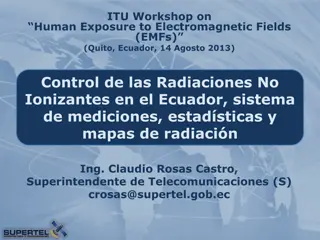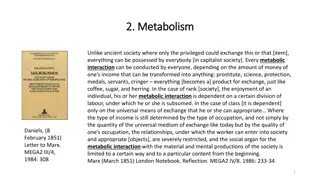Understanding Metabolic Rate Measurement Techniques
Metabolic rate, the amount of energy used by the body over time, can be measured in different ways using respirometers and calorimeters. Respirometers measure oxygen uptake, while calorimeters calculate metabolic rate based on heat generated by the organism. Understanding these techniques is essential for studying metabolism and energy expenditure.
Download Presentation

Please find below an Image/Link to download the presentation.
The content on the website is provided AS IS for your information and personal use only. It may not be sold, licensed, or shared on other websites without obtaining consent from the author. Download presentation by click this link. If you encounter any issues during the download, it is possible that the publisher has removed the file from their server.
E N D
Presentation Transcript
Metabolism and Survival Key Area 3a Measuring Metabolic Rate
Learning Intentions By the end of this topic you should be able to: Understand how the rate of metabolism can be measured;
You should already know: The pathway of blood through the human heart, lungs and body the structure of the human heart including the right and left atria and ventricles; red blood cells contain haemoglobin and are specialised to carry oxygen.
Metabolic Rate Metabolic rate is the quantity of energy used by the body over a given time. It is measured in kilojoules (or kilocalories). Glucose + Oxygen ---- > ATP + carbon dioxide + water Metabolic rate can be measured as Respirometers Oxygen consumption per unit time CO2 production per unit time Energy production (heat) per unit time
Measuring metabolic rate There are different ways to measure metabolic rate. Respirometers and Calorimeters are two different pieces of equipment that do this
Respirometers Respirometers measure the volume of oxygen uptake by an organism. If a man consumes 350L of oxygen on average per day this equates to 1700Kcal or 7000Kj
How a respirometer works Air used to zero scale The organism uses the O2 from the air during respiration. The CO2 it produces is absorbed by the chemical. As the air in the chamber is used up, more is pulled up from the capillary causing the liquid to move up the scale. The distance moved is equivalent to the O2 consumed This is sometimes called indirect calorimetry Chemical that removes CO2 from air Air is drawn from tube, pulling up liquid which can be measured on scale
Calorimeters Calorimeters measure the heat generated by an organism and calculates the metabolic rate from the results This experiment shows the heat produced by germinating peas. The right flask is the control. There should be no temperature rise in the control flask.
Direct Calorimeter A calorimeter measures the heat generated by an organism by comparing the temperature of water entering and leaving a well- insulated container.
Metabolic rate The energy expended by an organism can be broken down into three main parts 1. The BMR (Basal metabolic rate) the minimum energy required by an organism at rest 2. Physical Activity the more activity, the higher the energy cost 3. Dietary-induced thermogenesis cost of digesting and processing food
Basal metabolic rate (BMR) At rest, the metabolic rate is known as the basal metabolic rate (BMR). The BMR is low compared to the metabolic rate when the body is undergoing activities like exercise. During this resting state the body only needs to use energy to keep vital organs such as the heart, lungs and brain functioning properly.
Different organisms will have different BMR. Animal Volume of oxygen consumed (mm3 g 1 body mass h 1) Sea anemone 13 Octopus 80 Eel 128 Frog 150 Human 200 Mouse 1500 Hummingbird 3500
Comparative metabolic rate As a general rule, the greater the mass of an organism the higher that organism s metabolic rate is. However, BMR is higher per unit of body mass in small animals compared to larger ones. This is because the higher metabolic rate of small animals needs a greater delivery of oxygen to tissues around the body. Also, the smaller animals have a greater surface area to volume ratio, so more heat is lost
